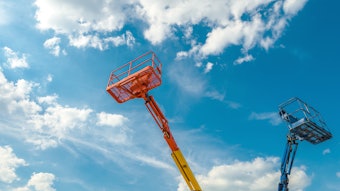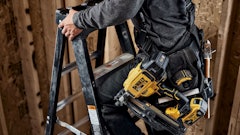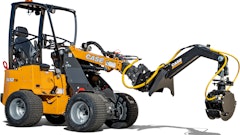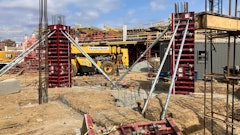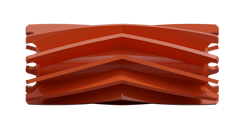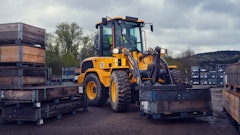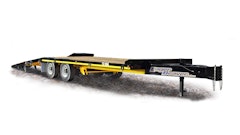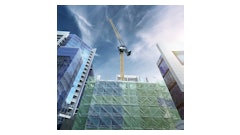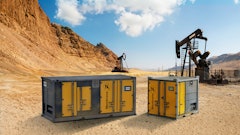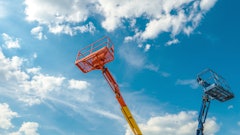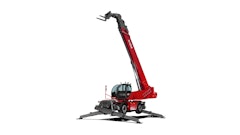
Manufacturers are increasingly offering attachments or workstations for aerial work platforms because of the added productivity they give to their users. Overhead work encompasses a multiplicity of activities such as welding, glazing, painting, wiring and maintenance, among many other tasks, and users need to take tools in the platform or use auxiliary power sources to perform these tasks.
The attachments also help make overhead work significantly safer. They are making overhead work so much safer that they have been endorsed by the national safety training organization, Aerial Work Platform Training (AWPT).
Tony Groat, AWPT's North American membership development director, says, "Today's increased use of aerial work platforms in all areas of work applications has expanded to incorporate many auxiliary tools, but also increased the risk associated with [AWP] use and the need for additional training and safety. Field application of these tools with aerial work platforms can create additional risk created by increased congestion of both the platform and on the ground below. There are risks of exceeding the capacity of the platform and of entangled or snagged lines from the platform."
He continues, "Factory-approved options and workstations greatly enhance the safety and productivity of the platform operator and those in the work area. Fully integrated tools improve machine mobility and accessibility for the operator. AWPT applauds the concept of incorporating electric, air and water lines running inside the boom from the base to the platform. They allow powered tools to be safely operated from the platform and eliminate the dangers and hassles of tethering lines draped over the platform railing to a separate machine on the ground where they can become a hazard to moving vehicles and ground personnel. Our organization supports anything that makes the operation of aerial work platforms safer."
The simplest of the attachments are fluorescent tube caddies, pipe racks and specialized cradles for glass and panels that are installed on the platform's rails. There are also a variety of tool trays for both scissor lifts and boom lifts which can include a vise, tool and parts holders, a 12-volt outlet to re-charge battery-operated hand tools and an electrician's tree to hold wire spools.
As Groat says, aerial work platform manufacturers are increasingly adding air and electrical lines routed through the boom to the platform with quick connects at the base. Compressors and generators can be attached to the machine at the base with outlets at the platform without the hazard of lines hanging down from the platform.
There is a drawback when lines are routed through the boom with a separate generator or compressor at the base, however. Work must stop every time the aerial work platform is moved so that the ground-based equipment can be moved as well. To overcome the mobility problem, JLG, Skyjack and Genie have added generators integrated into the engine compartment and powered with a hydraulic or belt link to the engine. JLG also has an optional air compressor that can be installed in the engine compartment and is powered by the generator. It is available for its boom lifts and delivers 9.3 cfm of air at 125 psi.
The generators have become so popular that Howard Kaplan, vice president and product parent at JLG says, "Our SkyPowerTM 7,500-watt generators are sold on most combustion-powered boom lifts and are standard equipment on 120-ft. and 135-ft. platform height boom lifts. On the 60-ft. and under boom lifts, either the 7,500-watt generator or a smaller generator are options."
Phil Harvey, Genie boom lift product manager, adds that not only are there generators for their combustion-powered boom lifts and for their electric-powered boom lifts. "Genie offers an optional 800-watt inverter that converts 48V DC to 120V AC power to allow operators to utilize a variety of power tools on the platform."
Genie also offers a 110V/60Hz inverter on all of its electric scissor lifts and an additional 230V/50Hz inverter choice on its two largest units, according to Eric Ludwig, Genie scissor lift product manager. On the combustion engine models, there is an optional 2,000-watt generator and for the largest rough-terrain models, there is also a welding option that includes a 12,500-watt generator with the welder.
Skyjack also offers optional generators on its new boom lifts. There is a basic 3,500-watt model and a step-up option for a welder-ready machine that includes a 12,000-watt hydraulic generator with an oil cooler. For Skyjack's electric-powered scissor lifts there is an optional 800-watt AC inverter and an optional shop airline to the platform. Skyjack's rough-terrain scissor lifts also offer the shop airline, inverter and a 2,000-watt hydraulic generator.
Since most customers have their own electric-powered hand tools, such as grinders, drills and saws, welders are the most common tool rented to utilize the built-in power sources and all three manufacturers have welding units to accompany their generators.
Kurt Kropp, vice president of Kropp Equipment, a multi-branch aerial work platform rental house based in Schererville, IN, says that not only steel erectors use welders, but his company has a number of glaziers that use them to fasten mullions. The welders are in such demand that his company has generators suitable for powering the welders installed on 200 of the boom and scissor lifts in the fleet. When they are rented with a welder, there is a 10- to 20-percent premium in the monthly rental rate.
He points out that with today's fuel prices, another selling point for his customers is the economy of onboard generators and welders since there is no need have fuel to run a separate piece of equipment. Kropp also says that his company has not encountered any particular maintenance problems with the generators or welders, and since they are securely fastened to the frame, overnight theft from parked units has not been an issue.
Besides powering welders and compressors, the generators incorporated into JLG and Genie machines can also power light towers to illuminate the work site.
In the past few years, aerial work platforms have gone from machines that lift workers into the air to multi-tasking tools that optimize productivity in a safer environment. The net effect is that the new technologies are helping dealers become more profitable while providing better service to their customers - a win-win situation.
|
Telehandlers: New ways for workers to reach the top Several independent manufacturers make personnel work platforms that fit on the forks of a telehandler, and they are also made by Gehl, JLG and Manitou for their own brands. Some of these have special features for added utility. Before buying any personnel work platform, buyers should determine whether the unit complies with ANSI/ITSDF B56.6-2005, the standards developed by the American National Standards Institute and Industrial Truck Standards Development Foundation. While it depends on the type of customer base a rental house has, "We recommend that every telehandler dealer keep at least one or two platforms in inventory to service customers," says Rebecca Yates, JLG telehandler specialist. Steve Kirst, Gehl product manager-telehandlers, reports that there are no particular maintenance problems associated with personnel work platforms, but Kirst does stress that "routine walk-around inspections are a good idea to ensure the baskets are in a safe condition. Also dealers should be sure that all safety manuals are attached to the unit and that all safety decals are in place and legible." For Manitou's rotating turret telehandlers where the cab and boom rotate as a unit, there are four models of personnel work platforms. They are internally wired with programming to operate the boom and safety features such as lowering the boom if there is engine failure. They also have kill switch to stop all operations. According to Ryan Ford, Manitou construction telehandler specialist, 95 percent of the rotating turret telehandlers are purchased with the platform predispositioned and a control box. Manitou also offers a fork-mounted platform for its conventional series of telehandlers with optional 180-degree swing carriage and wireless remote control boom option. Manitou does not allow the use of platforms on its trucks except for these specific models and only when equipped with all of the required safety systems. Gehl has three models: a fork-mounted unit and two specialized platforms. One is a 180-degree swing work platform directly mounted on the boom. It allows workers to adjust the location of the platform to a comfortable and safe working position even though the telehandler might not be able to be positioned correctly due to situations on the ground. The specialized Gehl personnel work platform, like the Manitou units, allows the worker in the platform to safely start and stop the telehandler's engine as well as raise/lower and extend/retract the boom without the need for a second worker to be in the cab of the machine. JLG's standard personnel work platform fits over the forks of all four of its telehandler brands: JLG, Gradall, Lull and SkyTrak. It features a removable front panel to allow operators to more easily get materials into and out of the platform. There is also a quick switch model for the JLG and Gradall models that allows the rapid change from forks to a platform directly attached to the boom. Summarizing the advantages of personnel work platforms for rental dealers Gehl's Kirst says, "The advantage of these types of platforms to the rental customer is that he saves money by only needing to rent one piece of equipment to do two jobs; and the advantage to the dealer is that he will experience greater rental utilization of his telehandler fleet." |




